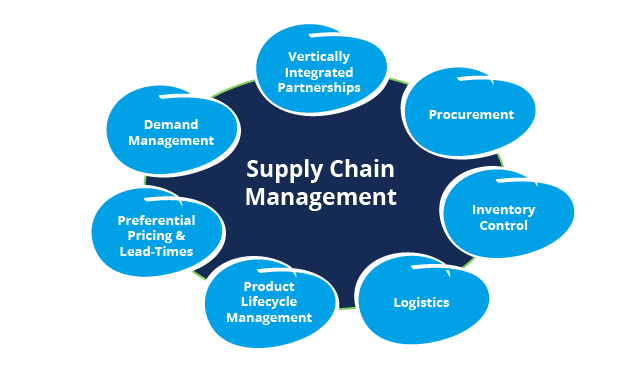Streamlining the Procurement Process in Supply Chain Management
Efficient procurement is a cornerstone of successful supply chain management, playing a pivotal role in ensuring the smooth flow of goods and services from suppliers to end-users. The procurement process encompasses a series of interconnected steps, each critical to the overall efficiency and effectiveness of the supply chain. In this comprehensive guide, we will delve into the intricacies of the procurement process in supply chain management, exploring its key components and highlighting best practices for optimal results.
1. Identification of Need:
The procurement process in supply chain management begins with the identification of a need within the organization. This need could be triggered by various factors, such as increased demand for a product or the introduction of a new project requiring specific resources.

2. Supplier Identification and Evaluation:
Once the need is identified, the next step is to identify potential suppliers. The purchasing process in supply chain management involves evaluating existing suppliers, conducting market research, and assessing the capabilities of new potential partners. Supplier evaluation includes considerations such as reliability, quality, pricing, and compliance with regulations.
3. Creation of Purchase Requisition:
After selecting the appropriate supplier, a purchase requisition is created. This document outlines the details of the requested goods or services, including specifications, quantity, and any other relevant information. The purchase requisition serves as an internal request that initiates the procurement process.
4. Purchase Order Issuance:
Upon approval of the purchase requisition, a purchase order (PO) is issued to the selected supplier. The PO is a legally binding document that outlines the terms and conditions of the purchase, including delivery schedules, payment terms, and any other relevant details.
5. Order Confirmation:
The supplier acknowledges the receipt of the PO by providing an order confirmation. This confirmation includes details such as the expected delivery date, any variations in pricing or quantities, and any additional terms or conditions.
6. Goods or Services Receipt and Inspection:
Upon delivery, the receiving department inspects the received goods or services to ensure they meet the specified criteria outlined in the PO. This step is crucial for maintaining quality standards and identifying any discrepancies or defects.
7. Invoice Approval and Payment:
After successful inspection and acceptance of the goods or services, the supplier issues an invoice. The procurement team reviews and approves the invoice for payment, taking into account any discounts or adjustments negotiated during the procurement process.
8. Supplier Performance Evaluation:
Periodic evaluation of supplier performance is essential for continuous improvement. This assessment may include factors such as delivery timeliness, product quality, adherence to specifications, and overall reliability. Supplier feedback informs decisions about ongoing relationships and potential improvements.
Best Practices for an Efficient Procurement Process
1. Strategic Planning:
Develop a robust procurement strategy aligned with organizational goals. The purchasing process in supply chain management involves understanding market trends, identifying potential risks, and establishing clear objectives for the procurement process.
2. Supplier Relationship Management:
Nurturing strong relationships with suppliers is key to a successful procurement process. Effective communication, collaboration, and transparency contribute to mutually beneficial partnerships.
3. Technology Integration:
Leverage technology to streamline and automate procurement processes. Implementing procurement software or an Enterprise Resource Planning (ERP) system enhances efficiency, reduces errors, and provides real-time visibility into the procurement lifecycle.
4. Risk Management:
Identify and assess potential risks in the procurement process. This includes risks related to supply chain disruptions, geopolitical factors, or changes in regulatory requirements. Implement risk mitigation strategies to minimize potential negative impacts.
5. Compliance and Ethics:
Adhere to ethical standards and legal compliance throughout the procurement process. This includes ensuring fair and transparent supplier selection, abiding by relevant regulations, and upholding ethical business practices.
6. Cost Optimization:
Optimize costs by negotiating favorable terms with suppliers, exploring bulk purchasing opportunities, and identifying areas for cost reduction without compromising quality. Continuous cost analysis is crucial for maintaining competitiveness.
7. Cross-Functional Collaboration:
Promote collaboration between different departments involved in the e procurement in supply chain management, such as finance, operations, and quality control. This ensures a holistic approach and alignment with organizational objectives.
Challenges in the Procurement Process
While the e procurement in supply chain management is integral, it is not without its challenges. Some common challenges include:
· Supply Chain Disruptions: Unexpected events, such as natural disasters or geopolitical tensions, can disrupt the supply chain and impact the procurement process.
· Supplier Reliability: Dependence on suppliers requires careful vetting to ensure reliability and prevent disruptions in the supply chain.
· Regulatory Compliance: Navigating complex and evolving regulations can pose challenges in maintaining compliance throughout the procurement process.
· Data Security: The increasing reliance on digital platforms introduces the risk of data breaches and requires robust cybersecurity measures to protect sensitive information.
Summary
Efficient procurement processes lie at the heart of a well-functioning supply chain. By optimizing procurement strategies, embracing technological advancements, and fostering strong supplier relationships, organizations can achieve cost savings, enhance quality, and mitigate risks within their supply chain ecosystems.
Author Bio
An efficient and well-managed procurement process is fundamental to the success of supply chain management. By understanding the key steps involved, adopting best practices, and addressing potential challenges, organizations can streamline their procurement processes, enhance collaboration with suppliers, and achieve optimal outcomes. In case you are searching for an efficient procurement management solution, contact Procqur today.
PROCQUR
Office No:26, 18th Floor, One By Omniyat, Business Bay, Dubai, UAE
971 42432543
Comments
Post a Comment